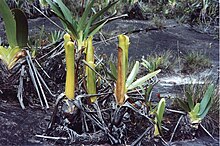| Brocchinia reducta | |
|---|---|

| |
| Brocchinia reducta on Mount Roraima | |
| Scientific classification | |
| Kingdom: | Plantae |
| Clade: | Tracheophytes |
| Clade: | Angiosperms |
| Clade: | Monocots |
| Clade: | Commelinids |
| Order: | Poales |
| Family: | Bromeliaceae |
| Genus: | Brocchinia |
| Species: | B. reducta
|
| Binomial name | |
| Brocchinia reducta Baker 1882
| |

| |
| Brocchinia reducta distribution | |
Brocchinia reducta /brɒˈkɪniə riːˈdʌktə/[1] is a carnivorous plant in the bromeliad family. It is native to southern Venezuela, Brazil, Colombia, and Guyana, and is found in areas with nutrient-poor, high moisture soil.[2][3][4][5] B. reducta is able to grow in sparse conditions, which is evident when it uses its roots as anchors over rocks.[6][7] Its funnel-like structure and waxy coating, among other characteristics, suggest that this plant is carnivorous.[8]
- ^ "Brocchinia reducta Baker | Plants of the World Online | Kew Science". Plants of the World Online. Retrieved 2023-10-16.
- ^ Hokche, O., Berry, P.E. & Huber, O. (eds.) (2008). Nuevo Catálogo de la Flora Vascular de Venezuela: 1-859. Fundación Instituto Botánico de Venezuela.
- ^ Funk, V. A., P. E. Berry, S. Alexander, T. H. Hollowell & C. L. Kelloff. 2007. Checklist of the Plants of the Guiana Shield (Venezuela: Amazonas, Bolivar, Delta Amacuro; Guyana, Surinam, French Guiana). Contr. U.S. Natl. Herb. 55: 1–584
- ^ Smith, L.B. & R. J. Downs. 1974. Pitcairnioideae (Bromeliaceae), Part I. Flora Neotropica, Monograph 14(1): 1–660
- ^ Cite error: The named reference
:0was invoked but never defined (see the help page). - ^ Cite error: The named reference
:1was invoked but never defined (see the help page). - ^ McPherson, Stewart (2007). "The Carnivorous Bromeliads". Florida Council of Bromeliad Societies.
- ^ Gaume, L; Perret, P; Gorb, E; Gorb, S; Labat, J.-J; Rowe, N (2004). "How do plant waxes cause flies to slide? Experimental tests of wax-based trapping mechanisms in three pitfall carnivorous plants". Arthropod Structure & Development. 33 (1): 103–111. Bibcode:2004ArtSD..33..103G. doi:10.1016/j.asd.2003.11.005. ISSN 1467-8039. PMID 18089026.